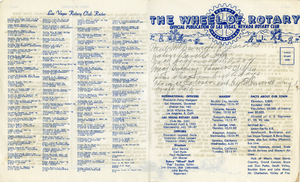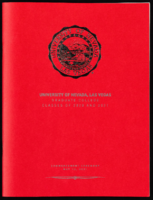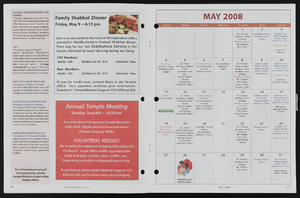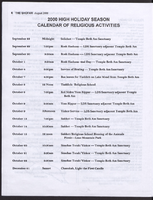Search the Special Collections and Archives Portal
Search Results

The Wheel of Rotary Las Vegas Rotary Club newsletter, January 12, 1950
Date
Archival Collection
Description
Text

University of Nevada, Las Vegas (UNLV) 2020 and 2021 graduate college commencement program
Date
Archival Collection
Description
Commencement program from University of Nevada, Las Vegas Commencement Programs and Graduation Lists (UA-00115).
Text
Soroptimist International Sierra Nevada Region Records
Identifier
Abstract
The Soroptimist International Sierra Nevada Region Records are comprised of memoranda, newspaper clippings, brochures, and communications from 1975 to 1998. The collection includes information about the Soroptimist International Sierra Nevada Region chapter's involvement with women's rights issues, primarily the Equal Rights Amendment ratification campaign in Nevada and California, as well as national efforts.
Archival Collection
Alan Byron Olson Photographs
Identifier
Abstract
The Alan Byron Olson Photographs (approximately 1933) consist of one negative album containing 100 photographic negatives taken by Alan Byron Olson around 1933 that depict the Hoover Dam (then known as Boulder Dam) and the Boulder City Hospital. Olson was a medic for the Boulder City Hospital and the images also depict various hospital staff and other locations related to Hoover Dam. The collection also includes digital copies of the negatives.
Archival Collection
Merle and Beulah Frehner Photograph Collection
Identifier
Abstract
The Merle and Beulah Frehner Photograph Collection contains photographs of Southern Nevada from 1905 to 1955. The materials include photographs of the Frehner freight teams transporting ore, schools and students in the Moapa Valley, the Colorado River, and parades in Southern Nevada.
Archival Collection

Tanya Olson oral history interview: transcript
Date
Archival Collection
Description
Oral history interview with Tanya Olson conducted by Claytee D. White on July 6, 2018 for the Remembering 1 October Oral History Project. In this interview, Olson recalls beginning October 2, 2017 to photograph scenes surrounding the aftermath of the shooting at the Route 91 Country Music Festival. Her efforts culminated in a film that highlights the Healing Garden, a memorial established after the shooting. It was dedicated on the first Friday of October 2017. Her 6-minute film, Forever In Our Hearts, is described as "Citizens unite to provide kindness and salve the wounds caused by the October 1, 2017 massacre during a Las Vegas country concert." The film was shown at the Nevada Women's Film Festival in 2018. Olson discusses beginning her latest endeavor, matriculating at the American Film Institute, a lifelong dream that she is pursuing after 23 years in the military, a film degree from University of Nevada, Las Vegas (UNLV), and completing her film project on one of the worst massacres in American history.
Text

Transcript of interview with Mary & Bruce Eaton by Beatrice Scheild, March 8, 1975
Date
Archival Collection
Description
On March 8, 1975, Beatrice Scheid interviewed Mary and Bruce Eaton about their lives in Boulder City, Nevada. Mary first talks about her life in the early days of Boulder City, specifically the influences of the churches and schools. She also talks about housing, transportation, and her career as an educator. Bruce (born 1904 in Toronto, Kansas) also talks about his life in Boulder City and his arrival to Southern Nevada as he sought employment in working on the building of Hoover Dam. Bruce talks about his employment with Six Companies, Inc. and discusses topics such as the employment wages, his and Mary’s experiences in building a house, and their experiences in buying a house built by Six Companies. Bruce also talks about the roles of Sims Ely, the city manager of Boulder City, and Frank Crowe, the construction superintendent of Six Companies. Bruce then discusses the issues of worker’s compensation as it related to work on the dam, and he describes, in detail, the cooling system us
Text
Selena Torres (Nevada Legislature, Assemblywoman) oral history interview conducted by Magdalena Martinez: transcript
Date
Archival Collection
Description
From the Lincy Institute "Perspectives from the COVID-19 Pandemic" Oral History Project (MS-01178) -- Elected official interviews file.
Text


